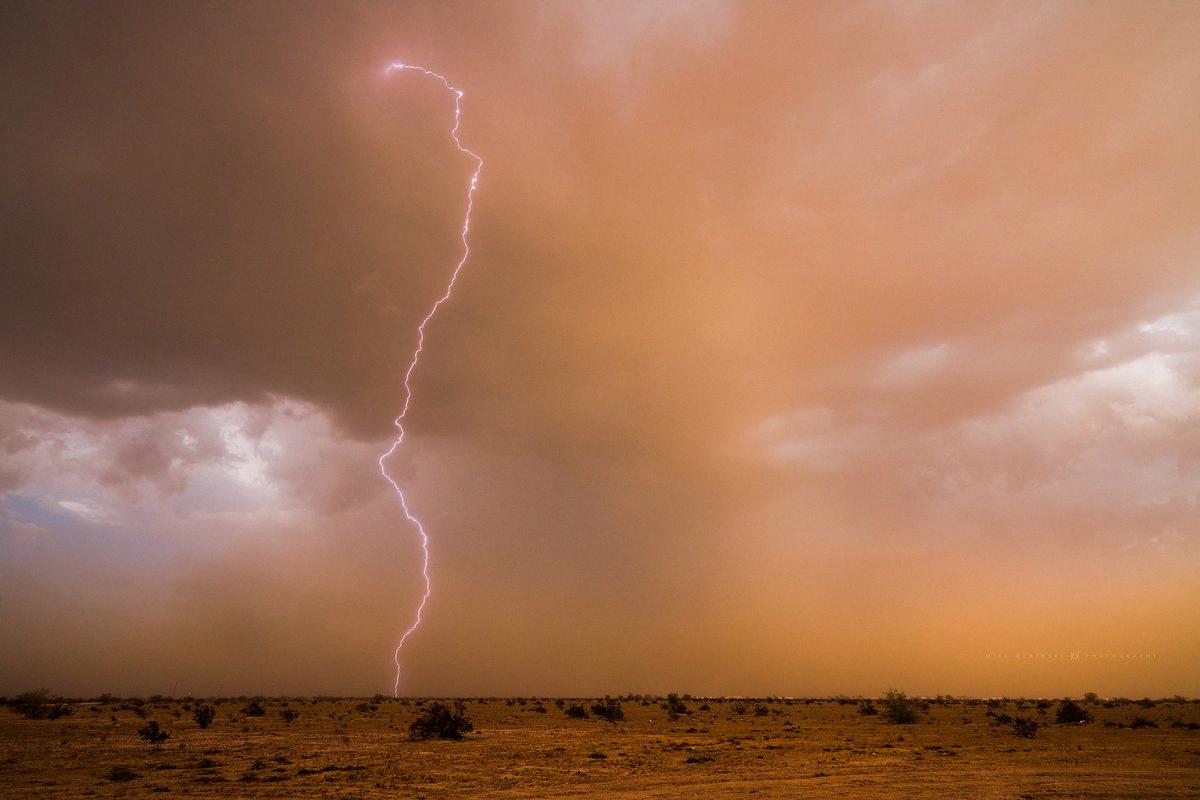Sandstorms are an incredible natural phenomenon that can be both fascinating and terrifying to witness. These massive windstorms, often found in desert regions, can generate incredible amounts of sand and dust, creating a haze that can be seen for miles. But, as many may wonder, do sandstorms have lightning?
The answer is yes, sandstorms can indeed produce lightning displays. However, the exact mechanisms behind this phenomenon are still not fully understood. Lightning is typically associated with thunderstorms, which are characterized by the presence of rain and a distinct vertical structure within the cloud. Sandstorms, on the other hand, are relatively flat and lack this vertical structure. So how is lightning produced in a sandstorm?
One theory suggests that the friction between sand particles during a sandstorm generates a static charge, similar to how static electricity is generated when you rub a balloon against your hair. This static charge builds up within the storm, eventually producing a lightning discharge. Another theory proposes that the strong updrafts within the storm provide enough energy to create a charge separation, leading to lightning.
Regardless of the exact mechanism, it is clear that sandstorms can produce some truly spectacular lightning displays. These lightning strikes can be especially dangerous, as they can ignite fires in dry desert regions. In fact, the NOAA Storm Prediction Center routinely issues forecasts for dry lightning, as this type of lightning is more likely to cause forest fires.
While sandstorms may not have the same vertical structure as thunderstorms, they are still capable of producing lightning. The exact mechanisms behind this phenomenon are still being studied, but it is clear that sandstorms can create some truly awe-inspiring displays of nature’s power.
The Possibility of Lightning During a Sand Storm
Yes, lightning can occur during a sandstorm. Sandstorms are ofen associated with thunderstorms, which are a common cause of lightning. Thunderstorms occur when warm, moist air rises and cools, causing water droplets to form and create a cumulonimbus cloud. These clouds can generate electrical charges due to the movement of particles within them. When the charges become large enough, a lightning bolt is generated.
During a sandstorm, strong winds can pick up large amounts of sand and dust, creating a dense cloud that can reach high altitudes. This can create the necessary conditions for a thunderstorm to form, and therefore lightning can occur. In fact, sandstorms are known to produce some of the most spectacular lightning displays.
However, the exact mechanisms behind how sandstorms generate lightning are still not fully understood. It is believed that the dust and sand particles may play a role in the formation of the electrical charges, but more research is needed to fully understand the process.

Difference Between Dust Storms and Sandstorms
While both dust storms and sandstorms are types of windstorms that can cause significant damage, there are some key differences between the two. A dust storm typically occurs in areas that are experiencing drought, where the soil has become dry and loose. As strong winds blow over this dry soil, the loose particles become airborne, creating a storm of dust-filled air that can reduce visibility and cause respiratory problems.
On the other hand, a sandstorm occurs in areas with sandy terrain, such as deserts or coastal regions. As the wind picks up speed, it lifts large amounts of sand particles into the air, creating a thick cloud of sand that can be carried over long distances. Unlike dust storms, sandstorms can also occur during periods of rain, as the moisture helps to bind the sand particles togther and make them more easily transported by the wind.
In summary, the main difference between a dust storm and a sandstorm lies in the type of particles that are carried by the wind. Dust storms involve loose soil particles, while sandstorms involve larger, more solid sand particles.
The Contents of a Sandstorm
A sandstorm, also known as a dust storm, is made up of an ensemble of particles of dust or sand that are energetically lifted to great heights by strong and turbulent winds. These particles can vary in size, ranging from small dust particles to larger sand particles. The exact composition of a sandstorm can depend on the location and the type of particles present in the area. In addition to dust and sand particles, a sandstorm can also contain various pollutants, such as soot, ash, and oher debris. The combination of high winds and airborne particles can create a dangerous and hazardous environment, reducing visibility and causing respiratory problems. As a result, sandstorms can pose a significant threat to people and animals in affected areas.
The Reality of Dry Lightning
Yes, dry lightning is a real phenomenon that occurs when lightning strikes the ground without any accompanying rain. This can happen in areas of low humidity or during drought conditions when there is not enough moisture in the air to create rain. Dry lightning is a serious concern because it can easily start wildfires, which can be difficult to contain and pose a threat to both people and wildlife. The National Oceanic and Atmospheric Administration’s (NOAA) Storm Prediction Center often issues warnings for dry lightning to alert people to the increased risk of wildfires during these conditions.
Can Dry Lightning Pose a Risk to Human Health?
Dry lightning can be dangerous, but it does not directly hurt you. The danger lies in the fact that dry lightning often occurs in areas that are dry and prone to wildfires. When lightning strikes the ground, it can ignite dry vegetation and start a fire that can quickly spread. In addition, dry lightning can also cause power outages and damage electrical equipment. If you are caught outside durng a dry thunderstorm, it is important to seek shelter immediately and avoid open fields, tall trees, and bodies of water. It is also important to stay informed about any wildfires that may be sparked by dry lightning in your area and follow any evacuation orders issued by local authorities.

The Rarity of Dry Lightning
Dry lightning, also known as thunderbolts or silent lightning, is a type of lightning that occurs without precipitation. It happens when lightning is produced by a thunderstorm that is too weak to produce rain, or when the rain evaporates before reaching the ground. In some cases, dry lightning can also be caused by wildfires or volcanic eruptions.
Dry lightning strikes are relatively rare in some parts of the world, including Northern and Central California, where they are infrequent enough to be overlooked by science. This is due to the unique climate and topography of the region, which creates conditions that are not conducive to the formation of thunderstorms.
However, in othr parts of the world, such as Australia and the southwestern United States, dry lightning is more common. In fact, it is a significant cause of wildfires in these regions and poses a serious threat to public safety and property. In such areas, it is important to take precautions to reduce the risk of fire and stay informed about weather conditions.
In summary, dry lightning strikes are relatively rare in some parts of the world, but can be more common in others. Understanding the risks and taking appropriate measures to protect oneself and property is essential in areas where dry lightning is a concern.
Can Humans Survive a Sandstorm?
Sandstorms can be dangerous and potentially life-threatening to humans, but it is possible to survive one with proper precautions. The key to surviving a sandstorm is to avoid being caught in one in the first place. If you are in an area prone to sandstorms, it is important to monitor weather reports and take shelter as soon as possible when a sandstorm is predicted.
If you do find yourself caught in a sandstorm, it is important to protect your eyes, nose, and mouth from the blowing sand. A face mask or cloth can be used to cover your nose and mouth, and goggles or sunglasses can help protect your eyes. It is also important to avoid breathing in the sand, as it can cause respiratory problems.
If you are driving durig a sandstorm, it is recommended to pull over and wait until the storm passes. Driving in a sandstorm can be dangerous, as visibility can be severely reduced, and sand can damage the vehicle’s engine and paint.
In summary, while sandstorms can be dangerous, it is possible to survive one with proper precautions. Avoiding being caught in a sandstorm, protecting your face and eyes, and avoiding breathing in sand are all important steps to take.
The Effects of a Sandstorm on the Skin
No, a sandstorm cannot take your skin off. While sandstorms, also known as haboobs, can be intense and caue skin irritation, they do not have the force or abrasiveness to remove skin. However, sandstorms can still be dangerous if you are caught in one without protection. The blowing sand can cause respiratory problems, eye irritation, and even lead to accidents due to low visibility. It is essential to seek shelter during a sandstorm and protect your skin and eyes with appropriate clothing and gear. So, while a sandstorm cannot take your skin off, it is still important to take precautions to avoid any potential harm.
Navigating a Sandstorm: Is Flight Possible?
Technically, it is possible to fly through a sandstorm or a dust storm. However, it is not recommended due to the significant hazards assocated with it. Sandstorms and dust storms can drastically reduce visibility, making it difficult for pilots to navigate and avoid other aircraft or obstacles. The strong winds associated with sandstorms can also affect an aircraft in flight, potentially causing turbulence or even structural damage. Ingesting the dust can also damage aircraft engines, leading to potential malfunctions or failures. Therefore, it is important for pilots to avoid flying through sandstorms and dust storms whenever possible to ensure the safety of the crew and passengers.

Source: twitter.com
The Dangers of Breathing In a Sandstorm
If you breathe in a sandstorm, you may experience immediate health effects, such as coughing, wheezing, and shortness of breath. The dust particles in the air can irritate your nose, throat, and lungs, leading to respiratory problems, espeially if you have asthma or other lung conditions.
Long-term exposure to dust from sandstorms can cause more serious health problems, such as chronic bronchitis, emphysema, and other lung diseases. Prolonged exposure to dust can also increase the risk of heart disease, stroke, and other cardiovascular problems. Additionally, inhaling sand and dust can lead to eye irritation and damage, especially if you wear contact lenses.
Overall, breathing in sandstorm dust is not recommended, and it is important to take protective measures, such as wearing a mask and staying indoors if possible, to avoid the negative health effects.
The Impact of Sand Storms on Human Health
Yes, sandstorms can hurt humans. The sand and dust particles in a sandstorm can cause physical harm and pose serious health risks. The sand and dust can get into the eyes, mouth, nose, and lungs, which can cause irritation, breathing difficulties, and infections. The particles can also cause skin irritation and abrasions. Moreover, sandstorms can pose a risk of accidents and injuries due to reduced visibility. Therefore, it is crucial to take the necessary precautions and seek medical attention in case of any symptoms or injuries caused by sandstorms.
Surviving a Sandstorm in a Car
Yes, it is possible to survive a sandstorm in a car. If you have access to a car durig a sandstorm, it can provide a safe shelter from the blowing sand and debris. However, it is important to take certain precautions to ensure your safety. First, make sure to turn off the engine and roll up all windows to prevent sand from entering the car. If necessary, use duct tape or towels to seal any gaps around the windows and doors. It is also recommended to turn on the car’s air conditioning system to filter the air and prevent the buildup of carbon monoxide. Additionally, it is important to remain calm and patient until the storm passes, as driving in a sandstorm can be extremely dangerous due to low visibility and slippery roads. Overall, if you are prepared and take the necessary precautions, surviving a sandstorm in a car is possible.
The Rarest Form of Lightning
The rarest form of lightning is known as ball lightning, which is also referred to as globe lightning. It is a rare aerial phenomenon that takes the form of a luminous sphere, generally measuring several centimetres in diameter. Unlike regular lightning, which appears as a bolt, ball lightning appears as a floating sphere that can last for several seconds before disappearing. Ball lightning is still not fully understood by scientists and is difficult to study due to its rarity, making it one of the most elusive and mysterious forms of lightning.
Does Silent Lightning Exist?
Yes, silent lightning does exist. The phenomenon of silent lightning is also referred to as heat lightning, which is a type of lightning that produces very little or no thunder sound. This happens when lightning occurs at a distance of more than 10 miles away from the observer. The sound of thunder is a result of the shock waves created by the sudden expansion of the heated air around the lightning bolt.
However, when lightning strikes far away, the sound waves produced are not strong enough to reach the observer’s location. Another reason for silent lightning is the atmospheric conditions that cause sound to be refracted or absorbed before it reaches the observer’s location. This is because the density of the air changes with changes in temperature and humidity, which can affect the speed of sound.
Therefore, while silent lightning is a rare phenomenon, it can occur when lightning strikes at a significant distance from the observer or when the atmospheric conditions cause the sound waves to be refracted or absorbed before they reach the observer.
The Benefits of Spider Lightning
Spider lightning is a unique type of lightning that is characterized by long, horizontally traveling flashes most commonly observed on the underside of stratiform clouds. The name “spider” comes from the appearance of the lightning, which resembles a spider’s web due to the branching and fractal-like structure of the flash. Spider lightning is often associated with positive cloud-to-ground (or +CG) lightning, which is the most powerful and dangerous type of lightning. This type of lightning occurs when the negatively charged base of a thundercloud emits a bolt of lightning that travels towards the positively charged ground. Spider lightning is thought to occur when the positive charge builds up in the upper regions of the cloud, creating a pathway for the lightning to travel horizontally before striking the ground. While spider lightning is a fascinating and beautiful natural phenomenon, it is important to remember that lightning can be extremely dangerous and precautions shuld always be taken to stay safe during thunderstorms.
Conclusion
In conclusion, sandstorms can indeed produce lightning, often referred to as “dry lightning” since it occurs without rain nearby. However, the exact mechanism by which sandstorms generate lightning remains a mystery to scientists. Despite this, the sight of lightning illuminating a sandstorm can be a spectacular sight, but it also poses a significant threat to the surrounding areas due to the risk of forest fires. Therefore, it is important for the NOAA Storm Prediction Center to issue forecasts for dry lightning to help prevent and mitigate the damage caused by such natural phenomena.
